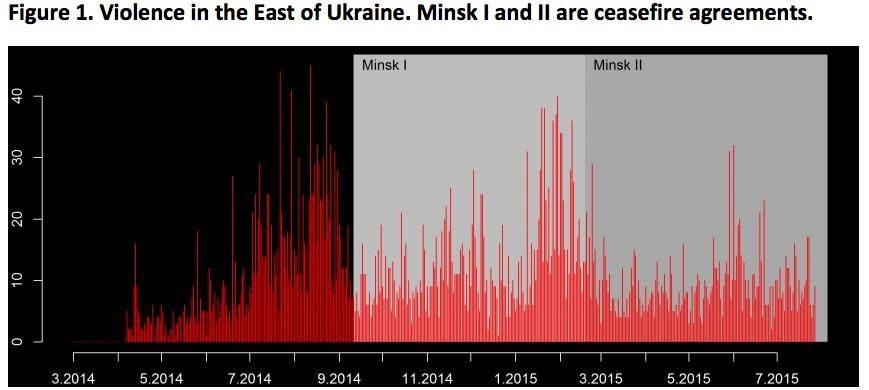Ukraine once again finds itself in the midst of a security, political, and economic turmoil. A former MP of Russian Duma Denis Voronenkov was assassinated and killed downtown Kyiv on March 23, 2017. Earlier the same week, a large Ukrainian military warehouse stockpiled with weapons was set on fire close to the border with Russia. Over the last several weeks, there have been continuing skirmishes (with loss of human life) in the East of Ukraine.
There is also some increase in tension between the political elites and the civil society. A notable example is a law passed recently by the Ukrainian parliament and signed by the President. This law requires members of the NGOs that are involved in anti-corruption effort to submit public e-declaration of their income. Some observers consider it to be an early sign of the pressure by the government and the president on activists involved in watchdog activities.
More importantly, there is now a trade blockade between the separatists-controlled territories and the mainland Ukraine. The blockade was originally initiated by some military veterans, politicians, and activists. During the initial stage of the blockade, the separatists have established control over a number of key private enterprises operating under Ukrainian authority on the separatists-controlled territories. Shortly after, the National Security Council of Ukraine (RNBO) has authorized the trade blockade until the control is restored. The National Bank of Ukraine has lowered its GDP growth forecast to 1.9% from the earlier projection of 2.8% partially due to the blockade’s effects. The Ukrainian State Statistical Service has reported a decrease in industrial growth in y-o-y terms by 4.6% after an increase 5.6% a month earlier (while the causes of the decrease are unclear, some of the analysts attribute it potentially to the trade blockade) [1]. Finally, the IMF has postponed its decision on the Ukrainian program until April 3rd to reassess the changed macroeconomic conditions.
A temporary worsening of the economic, political and security situation is nothing new for Ukraine. Over the last three years, there has been a pattern of the periods of relative calm followed by temporary escalations. The best data available to us that can confirm this can be found in the paper “Review of EU Security Policy towards Ukraine” by Tymofiy Mylovanov, Yuriy Gorodnichenko, and Yuri Zhukov, commissioned by the Human Security Study Group led by Mary Kaldor and Javier Solana.
Figure 1 (Mylovanov et al., 2016 p. 6) lists a measure of violence (number of incidents) in the East of Ukraine during 2014-2015.

In Fgiure 1, the horizontal axis depicts time and the vertical axis depicts a measure of violence (an average number of incidents per period). We see that violence spikes prior to Minsk I and Minsk II agreements. Nonetheless, the amount of violence is not constant and fluctuates between weeks of relative calms and intense fighting.
In this piece, I would like to propose a somewhat unusual perspective that the timing and the degree of escalation is endogenous to the situation in Ukraine. Of course, I do not deny that the causes for violence in Ukraine are geopolitical. I also agree that there could exist multiple plausible explanations for the timing and degree of escalations. [2] Instead, I just want to offer a perspective that might help us understand how Ukraine should structure its macroeconomic stabilization policies if the adversaries of Ukraine are trying to strategically use escalations to undermine Ukrainian’s objectives.
Specifically, I am going to assume that there exists a group of individuals and organizations (or countries), who are interested in destabilizing Ukraine. I consider them as a single player, in the terminology of the game theory, called “Opponent of Ukraine”. I further assume that the objective of this player is to minimize economic growth of Ukraine (we can also substitute this objective with that of delaying macroeconomic stabilization or something analogous). The goal is to think about how the optimal behavior of this player might look like.
The important point here is that the economic policies in Ukraine and the conceptual thinking underlying them treat “escalation” shocks as exogenous events or, sometimes, simply ignore them. Thus, the robustness of the policies that are being implemented in Ukraine to endogenous shocks by “Opponent of Ukraine” is an open question. If the policies are not robust, the opponent can hijack the future path of Ukraine by structuring her strategy of escalations optimally and manipulating behavior of the Ukrainian government.
In general, robust policies are less responsive (are constant) to the transitory shocks. This is to discourage the strategic behavior of the opponent. By contrast, the opponent who is interested in destabilizing a non-robust policy might find it optimal to behave stochastically. Her strategy would prescribe to randomly eslcalate in order to be unpredictable. At the same time, escalations are most effective if they follow periods of relatively long, but not too long calm. This would be effective in slowing down reforms. The idea is that the best time for escalation is just before the Ukrainian government is ready to undertake a next substantive step in a reform sequence. An escalation would distract the government and would also make it question whether the economy is ready to move onto the next reform. Finally, escalations should never be large enough to risk forcing the government to reconsider its current approach. Indeed, a strong enough escalation might compel the government to reconsider its policies in favor of a more robust approach. This perspective suggest that the optimal policy for the opponent is to escalate at random times, using different mechanisms, cluster these escalations prior to major reform milestones (a major law, a change in policy, passing a review of an important foreign donor), but keep these escalations relatively small.
What should be the optimal response of the Ukrainian government towards period escalations? If these escalations are endogenous, the Ukrainian government might consider more conservative but also more constant policies that do not respond strongly to escalations. It might also be useful to explore the idea or less transparent and more stochastic (less predictable) policies. As a specific example, the timing and the degree of relaxing capital controls can be determined by a stochastic rather than a deterministic criterion. If the escalations are exogenous than a more aggressive response policy is warranted. Serious empirical research is required to identify whether escalations are exogenous or not. I encourage Ukrainian and international economists to study this question.
Notes:
[1] The Ukrainian State Statistics Service reports a drop in the production of coal, coke, and steel. The enterprises that used to operate under the Ukrainian authority in the separatist-controlled territories are involved in productions chains of these products.
[2] For example, a reviewer suggested the following: “We usually see escalations before some negotiations involving Russia, Ukraine and Western partners. the purpose of these is both to show that Ukraine “also” does not hold the ceasefire and to create some slack for negotiations – like promising the ceasefire over and over again instead of further steps written in Minsk agreements”.
Attention
The author doesn`t work for, consult to, own shares in or receive funding from any company or organization that would benefit from this article, and have no relevant affiliations



